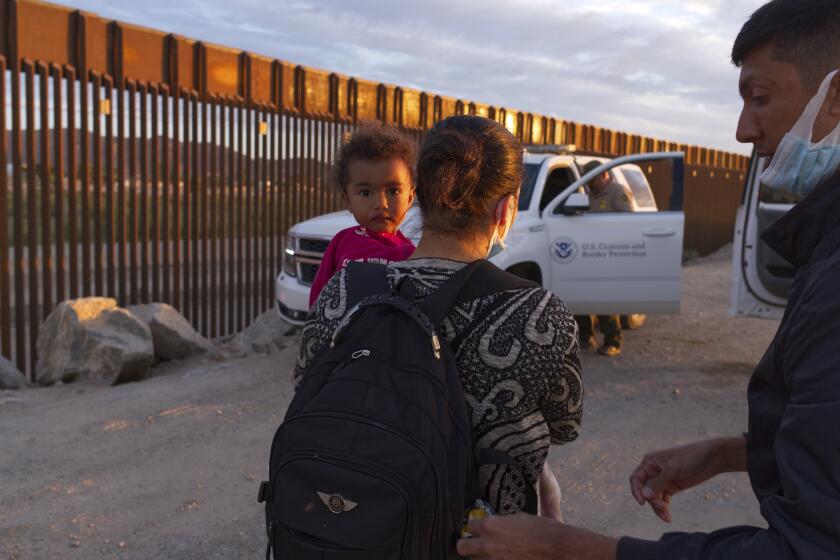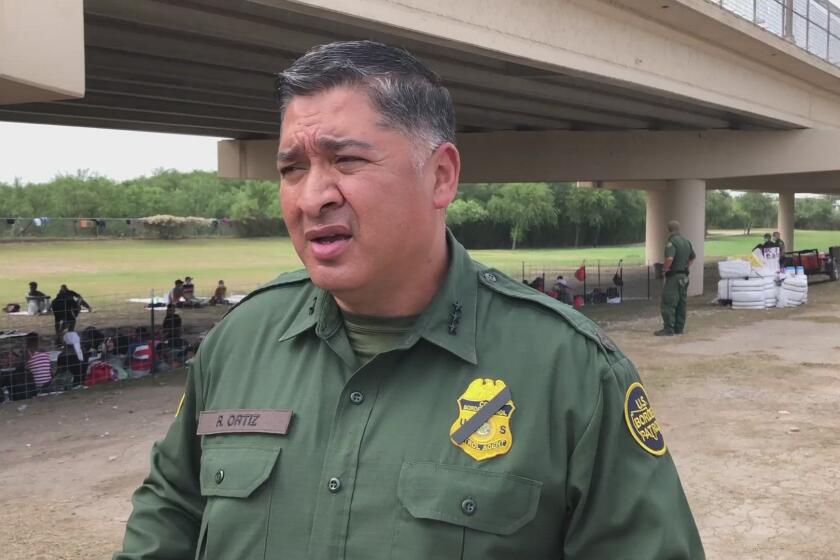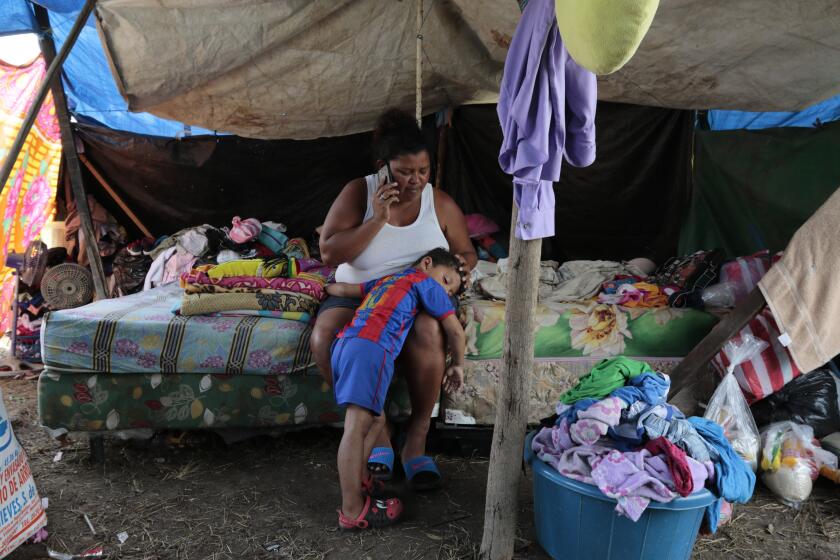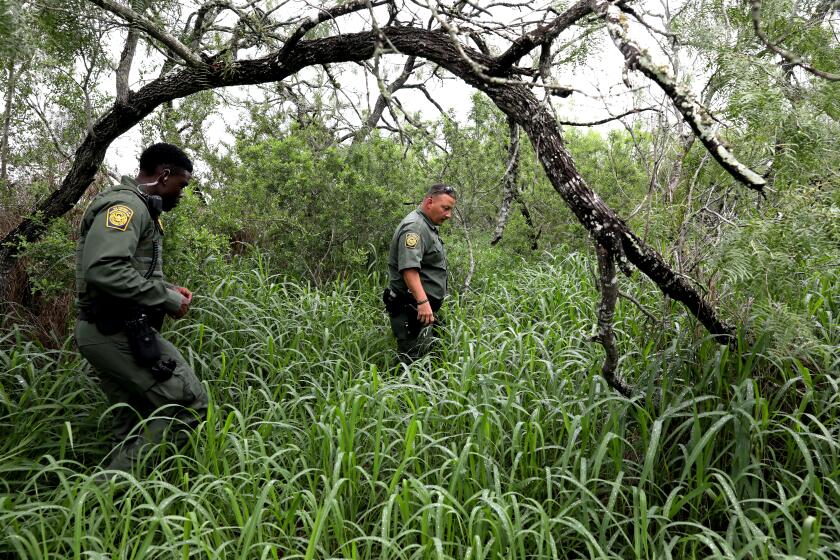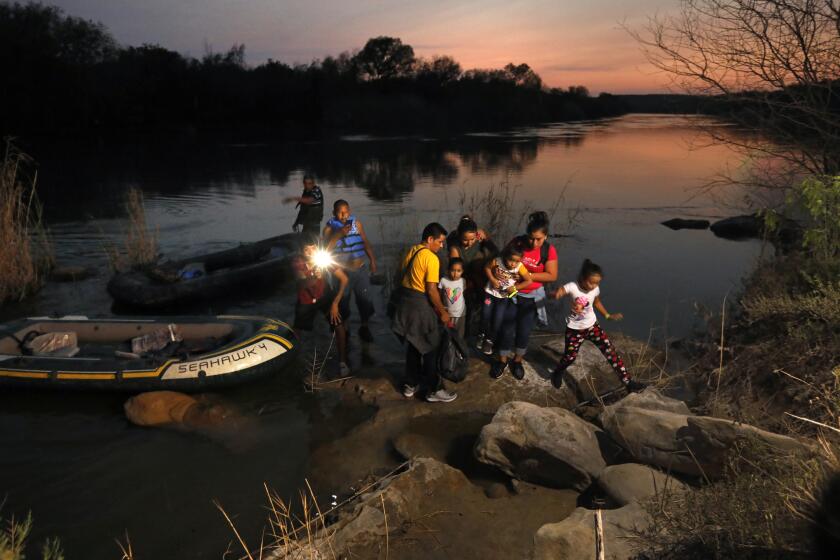Living in squalor, Guatemalan mudslide survivors see stark choice: Migrate to U.S. or die

- Share via
NUEVO QUEJÁ, Guatemala — The day before he left for the United States was a busy one for Victor Cal. He went from relative to relative, collecting money to buy food during the journey north.
His mother was inconsolable. “I begged him not to go, that we could live here,” she said, again and again, “but the decision had already been made.”
He and his parents shared a small lunch in silence. His mother’s gloom weighed upon him; he announced he had to find somewhere to charge his phone “to receive calls so the coyote can tell me where and when we will finally meet.”
He set off on a bumpy dirt road, looking to hitch a ride to any place with electricity. A motorbike pulled over and drove him to the nearest outlet, miles away.
At age 26, Cal felt he had to leave. The makeshift town where he lived, born of disaster, offered only hunger and death. It seemed the U.S. was the only way out.
Eleven men from his town have gone north in 2021. American authorities say they have stopped more than 150,000 Guatemalans at the border this year, four times the number in 2020.
U.S. officials say the number of migrant families they encountered at the border in June increased by 25% from May.
Many were like Cal, famished and impoverished. He served in the army, mustering out as a corporal. An Indigenous Maya who speaks Poqomchí, he failed to find work in Guatemala City. When the COVID-19 pandemic hit, he joined thousands who returned to their agricultural hometowns in the mountains.
His father’s land in Quejá, with its coffee, cardamom, corn and beans, sounded like a safe place. At least there would be food, he thought.
He was wrong.
In his worst nightmare, he could not imagine that a hurricane’s rains could bring a mountain down and destroy it all — house, land, town. He and his parents were left destitute by Hurricane Eta, displaced and dependent on relief from international organizations in a desperately shabby settlement called Nuevo Quejá.
The increasing tension has rattled the Del Rio area and conservatives nationwide, who have made it their battleground for border policy just as residents prepare for hunting season, when they fear shootings may erupt.
Cal lost pretty much everything else when a landslide buried his house. It had been raining for 25 days. The people of Quejá had been cooped up in their homes for 10 days; access roads had been cut off by flooding.
Without electricity, all the telephones were dead. Nobody told the villagers that the rain that fell over the previous 24 hours had been five times the average monthly amount; no one told them they were at risk, and they should leave.
It was lunchtime Nov. 5 when the first trees fell and the hillside began to melt. The townspeople left their food on the fire and ran.
“Those of us who had time to flee could only carry our children on our backs,” says one of the survivors, Esma Cal, 28, an energetic woman who would assume a role as a community leader in the aftermath. (Many of the people of Quejá share the same last name, Cal, though it is not always clear how they might be related.)
Back-to-back hurricanes devastating Nicaragua and Honduras, strained by five years of drought, will only add to the region’s migration problem.
Fifty-eight people disappeared in seconds. Most of the bodies will never be recovered. Forty homes were buried, and dozens of others were left inaccessible.
Crossing torrents of water on ropes, the survivors walked to the nearest town. Residents shared with them their remaining food and put them up in schools and at the market. Because of the isolation, no trucks could arrive with supplies. When helicopters finally arrived, “some of us had been without food for almost two days,” said Esma Cal.
By January, she, Erwin Cal, childhood friend Gregorio Ti and others organized a development council. By February, they had founded a temporary settlement on a third of their agricultural land, close to their buried homes. Perhaps it was not safe from another landslide, but it was accessible.
Thus was born Nuevo Quejá, home to about 1,000 survivors.
News Alerts
Get breaking news, investigations, analysis and more signature journalism from the Los Angeles Times in your inbox.
You may occasionally receive promotional content from the Los Angeles Times.
“We know how to work,” said Ti, 36. He lost his pregnant wife, his 2- and 6-year-old sons and his mother in the mudslide; his surviving daughters, 11 and 14, cling to his side.
The toil is constant and backbreaking. All day long, men, women and children cut and transport wood and clear land with machetes.
The shacks are constructed with zinc sheets donated by a priest and wooden planks made from pine trees the villagers cut down. Holes in the roofs allow rainwater to pour inside; holes between the wall planks are patched with rags.
The government has never been much help. After the mudslide, it declared the new settlement uninhabitable.
Corruption underscores the challenge Harris confronts in working with leaders of El Salvador, Guatemala and Honduras to stem migration to the U.S.
“Apart from declaring the place uninhabitable,” said Esma Cal, “the government of Guatemala has been absent. Period.”
The townspeople have received some help from nongovernmental organizations that drew funding from the U.S. Agency for International Development. UNICEF donated a new school to the community, but it has been closed for five months because no one could find the key to open it. It turns out that UNICEF gave the key to a teacher who then resigned and left with it. A second copy was given to a community member who denied having it.
So instead, school was held in the shack next door, in chairs donated by the European Union. But like every other shack, it leaks, and the floor is often flooded and muddy.
The school serves 250 children. Of the 12 teachers who worked there before the storms, four remain to teach despite a lack of a permit from the Education Ministry. Their materials are in Spanish; the students speak only Poqomchí, said a teacher who spoke on condition of anonymity, for fear of consequences.
“None of them will go to high school. They already lost years. School failure is total,” the teacher said.
The agency’s approach to missing migrants has evolved amid an increase in migration and deaths.
Before the hurricane, the children were healthier. “Today, it is rare for a child to have the correct weight and height,” said César Chiquin, 39, the nurse in charge of the area. “Virtually all are at risk.”
This is the central plight of the people of Nuevo Quejá. Struggle as they might, they can’t raise enough food to sustain themselves. Part of the problem is timing. Having lost last year’s crops to the hurricanes, “we arrived in Nuevo Quejá too late for planting properly,” Esma Cal says.
They also have just a third as much land as they did before the storms. And a lot of the soil has been degraded — torrential rains wash away the topsoil, black and fertile, and leave behind orange clay.
“Our community is under collapse and we need a permanent solution. This place is not fit to live in, and for the moment we have no way out,” Cal said. “Our real problem is that we have no land and we are dependent. We, as a farming community, need land.”
Wet sweatshirts. Toddler shoes. A line of Scripture. These are some of the things left behind by migrants making their way across the Rio Grande.
In the meantime, people are dying in the squalor of the settlement. In July, 17-year-old Flor Maribel Cal lay in bed with a tumor on her right leg the size of a soccer ball. She was in intense pain, vomiting, malnourished. She died July 22.
Death is one of only two ways out of Nuevo Quejá. The other is immigration to the U.S.
Víctor Cal contacted a distant cousin who has been in Miami for years. He agreed to advance the $13,000 to buy a coyote package that offers two attempts to enter the U.S.
Optimistic, Cal was convinced that he will be able to earn enough to repay his cousin.
Start your day right
Sign up for Essential California for the L.A. Times biggest news, features and recommendations in your inbox six days a week.
You may occasionally receive promotional content from the Los Angeles Times.
It was 4 a.m. when Victor Cal took a scrap of paper and wrote his number and the number of the coyote who would take him to the Arizona desert.
He left it on the table, one of the few pieces of furniture in the dirt-floored shack. “My objective,” he repeated, as if to convince himself, “is to be able to send money so my parents have a real house again and some land.”
He added: “If I had a choice, I wouldn’t go. I will be back as soon as possible.”
He said goodbye without looking back at Nuevo Quejá.
More to Read
Sign up for Essential California
The most important California stories and recommendations in your inbox every morning.
You may occasionally receive promotional content from the Los Angeles Times.
